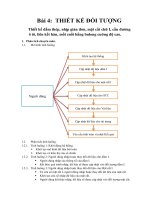Singleton, template method (THIẾT kế đối TƯỢNG SLIDE)
Bạn đang xem bản rút gọn của tài liệu. Xem và tải ngay bản đầy đủ của tài liệu tại đây (580.8 KB, 45 trang )
The Singleton Pattern
“One of a Kind Objects”
1
Singleton: What is this?
•
•
•
How to instantiate just one object - one and only one!
Why?
–
Many objects we need only one of: thread pools, caches, dialog boxes, objects that handle
preferences and registry settings, etc.
–
If more than one instantiated: Incorrect program behavior, overuse of resources, inconsistent results.
Alternatives:
–
–
Use a global variable: assign an object to a global variable, then that object might be created when
application begins.
•
Downside: If application never ends up using it and object is resource intensive --> waste!
Use a static variable
•
How do you prevent creation of more than one class object?
2
The Little Singleton
How would you create a single object?
new MyClass();
And what if another object wanted to create a MyClass?
Yes, why not.
Could it call new on MyClass again?
Can we always instantiate a class one or more times?
Yes. Caveat: Only if it is public class
And if not?
If it's not a public class, only classes in the same
package can instantiate it, but they can instantiate it
more than once.
Is this possible?
Yes. It is a legal definition
public class MyClass {
private MyClass() { }
}
What does it mean?
A class that can’t be instantiated because it has a
private constructor
3
The Little Singleton (con't)
Is there any class that could use a private constructor?
MyClass is the only code that could call
it.
What does this mean?
We can call the static method:
public class MyClass {
MyClass.getInstance()
public static MyClass getInstance() { }
}
Now, can I instantiate a MyClass?
Yes
public class MyClass {
private MyClass() { }
public static MyClass getInstance() {
return new MyClass();
}
}
How you would create a MyClass object now?
MyClass.getInstance()
Can you create now more than one MyClass?
Yes, why not?
4
The Little Singleton (con't)
But I would like to have
public MyClass {
private static MyClass oneClass;
only one MyClass. How
you do it?
private MyClass() { }
public static MyClass getInstance() {
if (oneClass == null) {
oneClass = new MyClass();
}
return oneClass;
}
}
5
The Classic Singleton Pattern
static variable to hold our one instance of the class
Singleton.
public class Singleton {
private static Singleton uniqueInstance;
// other useful instance variables
private Singleton() {
}
Constructor is declared private;
only singleton can instantiate this class!
public static Singleton getInstance() {
The method instantiate the class and return
if (uniqueInstance == null) {
an instance of it.
uniqueInstance = new Singleton();
}
return uniqueInstance;
}
// other useful methods
}
Singleton is a regular class, so it has other useful instances and
methods.
6
Code Up Close
uniqueInstance holds our ONE instance; it is a static
If uniqueInstance is null, then we haven’t created the
variable
instance yet…
if (uniqueInstance == null) {
uniqueInstance = new Singleton();
}
return uniqueInstance;
If uniqueInstance wasn’t null, then it was
and if it doesn’t exist, we instantiate Singleton through its private constructor
previously created. We have an instance and
and assign it to the uniqueInstance.
we return it.
Note that if we never need the uniqueInstance, it never gets created → lazy
instantiation.
7
Singleton Pattern Defined
The Singleton Pattern ensures a class has only one instance, and provides a global point of access to
it.
Singleton
The getInstance() method is static, which
- static uniqueInstance
means it is a class method, so you can conveniently
// other useful variables
The uniqueInstance class variable
holds our one and only one instance of
Singleton.
access this method anywhere using
Singleton.getInstance()
+ static getInstance()
// other methods
A class implementing a Singleton Pattern is more than a
Singleton; it is a general purpose class with its own set of
data and methods.
8
Computer controled chocolate boiler
public class ChocolateBoiler {
private boolean empty;
The job of boiler is to take in chocolate and milk, bring them to a boil, and then
pass them on to the next phrase of making the bars
private boolean boiled;
public ChocolateBoiler() {
empty = true; boiled = false;
}
public void fill() {
if (isEmpty()) {
To fill the boiler it must be empty, and, once it's full, we set
the empty and boiled flags
empty = false;
boiled = false;
// fill the boiler with a milk/chocolate mixture
}
To drain the boiler it must be full (not empty) and also boiled. Once it
}
public void drain() {
is drained we set empty back to true
if (!isEmpty() && isBoiled()) {
// drain the boiled milk and chocolate
empty = true;
}
To boil the mixture, the boiler has to be full and not already boiled.
}
public void boil() {
Once it is boiled we set boiled flag to true
if (!isEmpty() && !isBoiled()) {
// bring the contents to a boil
boiled = true;
}
}
public boolean isEmpty() { return empty; }
public boolean isBoiled() { return boiled; }
}
9
Turning ChocolateBoiler into singleton
public class ChocolateBoiler {
private boolean empty;
private boolean boiled;
private static ChocolateBoiler uniqueInstance;
private ChocolateBoiler(){
empty = true;
boiled = false;
}
public static ChocolateBoiler getInstance() {
if (uniqueInstance == null) {
uniqueInstance = new ChocolateBoiler();
}
return uniqueInstance;
}
public void fill() { ... }
10
Houston, we have a problem….
•
We improved the Chocolate Boiler code with the Singleton pattern and we added
some optimizations to the Chocolate Boiler Controller that makes use of multiple
threads
•
Ugh… the Chocolate Boiler’s fill() method was able to start filling the boiler even
though a batch of milk and chocolate was already boiling! That’s 500 gallons of milk and
chocolate spilled.
•
Could the addition of threads have caused this?
11
Be the JVM
•
We have two threads each executing this code:
ChocolateBoiler boiler = ChocolateBoiler.getInstance();
boiler.fill();
boiler.boil();
boiler.drain();
•
Could the two threads get hold of different boiler objects?
public static ChocolateBoiler getInstance() {
if (uniqueInstance == null) {
uniqueInstance = new ChocolateBoiler();
}
return uniqueInstance;
}
12
What happened?
Value of
Thread 1
Thread 2
uniqueC
null
ChocolateBoiler getInstance();
ChocolateBoiler getInstance();
null
if (uniqueC == null) {
null
if (uniqueC == null) {
null
uniqueC = new ChocolateBoiler();
object1
return = uniqueC;
object1
uniqueC = new ChocolateBoiler();
object2
return = uniqueC;
object2
13
Dealing with Multi-threading
•
Easy fix: make getInstance() a synchronized method
public class Singleton {
Adding the synchronized keyword force every thread to wait
private static Singleton uniqueInstance;
its turn before it can enter the method.
// other useful instance variables here
That is, no two threads may enter the method at the same
time.
private Singleton() {}
public static synchronized Singleton getInstance() {
if (uniqueInstance == null) {
uniqueInstance = new Singleton();
}
return uniqueInstance;
}
// other useful methods here
}
•
•
This fixes the problem, but synchronization is expensive.
Synchronization is really only needed the first time through this method. Once we have created the first Singleton
instance, we have no further need to synchronize this method.
14
Can we improve multithreading?
1.
Do nothing if the performance of getInstance() isn’t critical to your application. (remember
that synchronizing can decrease performance by a factor of 100)
2.
Move to an eagerly created instance rather than a lazily created one.
Go ahead and create an instance of Singleton in a static initializer.
This code is guaranteed to be thread safe!
public class Singleton {
private static Singleton uniqueInstance = new Singleton();
private Singleton() {}
public static Singleton getInstance() {
return uniqueInstance;
}
We’ve already got an instance, so just return
it.
}
15
Can we improve multithreading?
•
Use “double-checked locking” to reduce the use of synchronization in getInstance()
If performance is an issue then this method can
drastically reduce overhead!
public class Singleton {
private volatile static Singleton uniqueInstance;
Check for an instance and if there
isn’t one, enter the synchronized
private Singleton() {}
block.
we only synchronize the first time
public static Singleton getInstance() {
through.
if (uniqueInstance == null) {
synchronized (Singleton.class) {
if (uniqueInstance == null) {
uniqueInstance = new Singleton();
The volatile keyword ensures that
}
multiple threads handle
}
uniqueInstance variable correctly
when it is being initialized to the
}
Singleton instance.
return uniqueInstance;
}
}
Once in the block, check again if null. If so create instance.
16
Summary
•
•
•
The Singleton Pattern ensures you have at most one instance of a class in your application
•
Examine your performance and resource constraints and carefully choose an appropriate
Singleton implementation for multi-threaded applications.
•
Be careful if you are using multiple class loaders -- this can defeat the purpose of the
Singleton implementation
The Singleton Pattern also provides a global access point to that instance.
Java’s implementation of the Singleton Pattern makes use of a private constructor, a static
method combined with a static variable
17
The Template Method Pattern
Encapsulating Algorithms
18
Time for some more caffeine ...
Starbuzz Coffee Barista Training Manual
Baristas! Please follow these recipes precisely when preparing Starbuzz beverages.
Starbuzz Coffee Recipe
Starbuzz Tea Recipe
(1)
(2)
(3)
(4)
1)
2)
3)
4)
Boil some water
Brew coffee in boiling water
Pour coffee in cup
Add sugar and milk
Boil some water
Steep tea in boiling water
Pour tea in cup
Add lemon
The recipe for coffee and tea
are very similar!
19
Whipping up some Coffee in Java
public class Coffee {
void prepareRecipe() {
boilWater();
brewCoffeeGrinds();
pourInCup();
Recipe for coffee - each step is implemented as a separate
method.
addSugarAndMilk();
}
public void boilWater() {
System.out.println("Boiling water");
}
Each of these methods implements one
step of the algorithm.
public void brewCoffeeGrinds() {
System.out.println("Dripping Coffee through filter");
}
public void pourInCup() {
System.out.println("Pouring into cup");
}
public void addSugarAndMilk() {
System.out.println("Adding Sugar and Milk");
}
}
20
And now for the Tea …
public class Tea {
void prepareRecipe() {
boilWater();
steepTeaBag();
pourInCup();
Very similar to the coffee –
2nd and 4th steps are different.
addLemon();
}
public void boilWater() {
System.out.println("Boiling water");
These methods are exactly the same
as the are in Coffee
}
public void steepTeaBag() {
System.out.println("Steeping the tea");
}
public void pourInCup() {
System.out.println("Pouring into cup");
}
These methods are specialized to
Tea
public void addLemon() {
System.out.println("Adding Lemon");
}
}
We have code duplication - that’s a good sign that we need to clean up the design. We should abstract the commonality
into a base class since coffee and tea are so similar, right?
21
Sir, may I abstract your Coffee, Tea?
CaffeineBeverage
The prepareRecipe() method differs
The boilWater() and pourInCup() are
prepareRecipe()
in each subclass, so it is defined as
abstract.
boilWater()
shared by both subclasses, so defined in the
pourInCup()
superclass.
Tea
Coffee
prepareRecipe()
brewCoffeeGrinds()
addSugarAndMilk()
prepareRecipe()
steepTeaBag()
Each subclass overrides the
prepareRecipe() method and
implements its own recipe.
addLemon()
The methods specific to Coffee and Tea stay in the
subclasses.
Is this a good redesign? Are we overlooking some other commonality? What are other ways that Coffee and Tea are
similar?
22
What else do they have in common?
•
Both the recipes follow the same algorithm:
1.
Boil some water
2.
Use hot water to extract the tea or coffee
3.
Pour the resulting beverage into a cup
4.
Add the appropriate condiments to the beverage.
These two are already abstracted into the base
class
These aren’t abstracted but are the same, they just apply to different
beverages.
Can we abstract prepareRecipe() too? Yes ...
23
Abstracting PrepareRecipe()
•
Provide a common interface for the different methods
–
Problem : Coffee uses brewCoffeeGrinds() and addSugarAndMilk() methods while Tea uses
steepTeaBag() and addLemon() methods
–
Steeping and brewing are pretty analogous – so a common interface may be the ticket: brew() and
addCondiments()
public class Coffee {
public class Tea {
void prepareRecipe() {
void prepareRecipe() {
boilWater();
boilWater();
brewCoffeeGrinds();
steepTeaBag();
pourInCup();
pourInCup();
addSugarAndMilk();
addLemon();
}
}
public abstract class CaffeineBeverage {
void prepareRecipe() {
boilWater();
brew();
pourInCup();
addCondiments();
}
24
Abstracting prepareRecipe()
CaffeineBeverage
CaffeineBeverage
prepareRecipe()
prepareRecipe()
boilWater()
boilWater()
brew()
pourInCup()
pourInCup()
addCondiments()
Coffee
Tea
Tea
Coffee
prepareRecipe()
brewCoffeeGrinds()
addSugarAndMilk()
prepareRecipe()
steepTeaBag()
addLemon()
brew()
brew()
addCondiments()
addCondiments()
25









